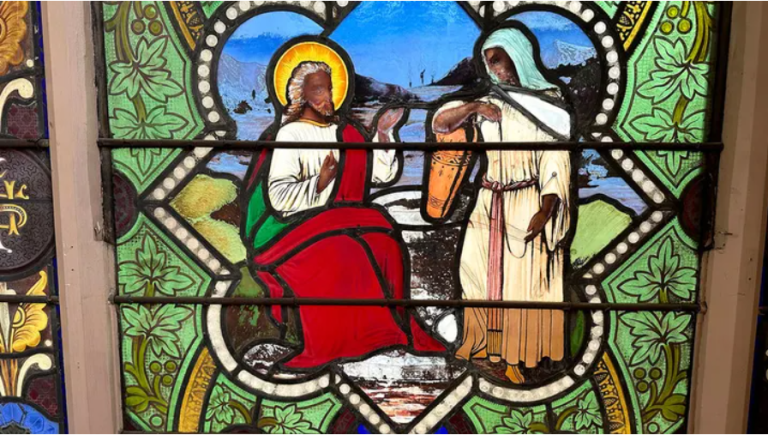
A stained-glass window showing Jesus Christ as a person of color has brought analysis into the role of slavery, race, and gender in 19th-century New England. The window, which ornaments St. Mark’s Episcopal Church in Warren, Rhode Island, illustrates Jesus as a dark-skinned man while talking to a dark-skinned Samaritan woman at the well.
Another scene in the 12-feet tall, five-foot window shows Jesus talking with Martha and Mary before He raised Lazarus from the dead. The window was installed in 1878 while the United States was reeling during the Civil War aftermath and the resultant work of Reconstruction, which ended the year prior. The church building closed in 2010.
Virginia Raguin, a stained-glass expert who also works as a professor of humanities emerita at the College of the Holy Cross in Worchester, Massachusetts, pointed out that it’s the only stained-glass portrayal of a dark-skinned Jesus from that era that she knows about. She said, “This window is unique and highly unusual. I have never seen this iconography for that time.”
She also said, noting the window shows Jesus interacting with women as equals, “Both stories were selected to profile equality.” The window, fashioned by the Henry E. Sharp studio in New York, was mostly forgotten until it was found again when Hadley Arnold and her family bought the church to transform it into a home after it closed in 2010 after 180 years.
Arnold, who noticed the dark-skinned portrayal when she had the windows removed to replace them with clear glass, said, “The skin tones were nothing like the white Christ you usually see.” Scholars are supposedly studying the potential intentions of the artist and Mary P. Carr, the woman who commissioned the window in memory of her aunts who married into families involved in the slave trade.
According to Arnold, the artist’s intentions remain unclear. She asked, “Is this repudiation? Is this congratulations? Is this a secret sign?” Arnold also added that she doesn’t feel comfortable saying the window shows Jesus as a Black man, preferring to say that it shows him as a person of color from the Middle East.
She added that the window was made during President Hayes’ administration after the Compromise of 1877, which settled a disputed presidential election, effectively ending a Reconstruction-era push to guarantee formerly enslaved Black Americans full civil rights.
Arnold said of Carr, “We don’t know, but it would appear that she is honoring people of conscience, however imperfect their actions or their effectiveness may have been. I don’t think it would be there otherwise.” Some may think the window shows Jesus as a Black man, but scholars believe the artist meant to portray Him as a brown man from the Middle East.
Either way, this stained-glass depiction of Jesus is causing controversy in this small New England town and throughout the country.
